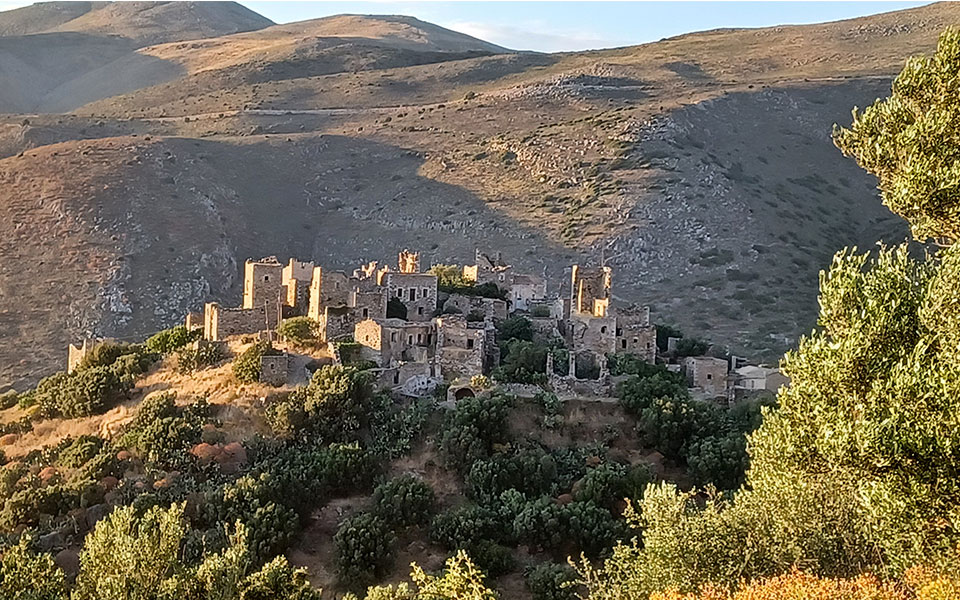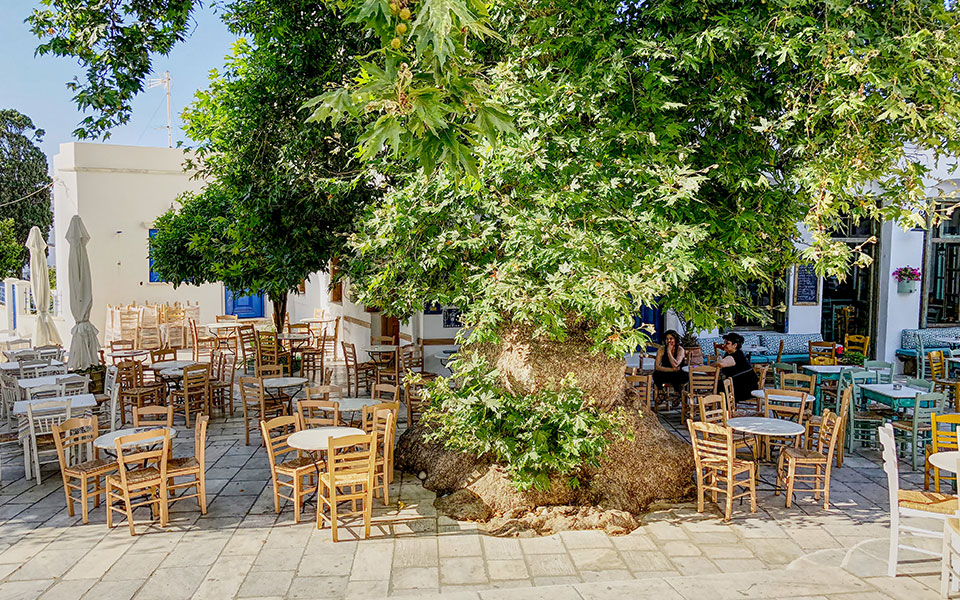A country that exudes geographic gorgeousness like Greece also offers an array of scenic drives to match. And fall is arguably the best season to follow those long and winding roads to unforgettable scenery with no shortage of intriguing stops along the way. Leave the moodiness or mistiness to northern climes; here, the autumn light throws the contours of mountain and sea into ever sharper relief, yet the days are still long enough to allow for leisurely roadside rambles.
In America and much of Europe, fall drives are synonymous with crisp air and fall foliage as leaves change from green to red and gold. As a Mediterranean country, Greece serves up a different roadside aesthetic. Olive trees don’t change color, but their leaves glisten a distinctive, silvery green in the Greek autumn breeze… With that in mind, here are five suggestions to get your wheels turning.

© Shutterstock
1. The Eastern Attica Loop
Athens is the starting point for a leisurely self-guided driving tour of some of the best sights the Attica region offers — but you should start outside the tangle of Athenian traffic by setting off from Piraeus, the port of Athens. Locals may take it for granted, but the Akti Themistokleous, the circular coastal road named for the ancient Athenian general Themistocles, is a revelation. Remnants of ancient walls tumble down to the sea, enhanced by the relaxed seafood tavernas that overlook them. Fuel up and keep driving along the coast — you’ll be heading in a northerly direction — past the busy southern suburbs of Faliro and Glyfada until you get to Vouliagmeni, home of upscale beaches and the namesake lake at the foot of Mount Imittos. This is where the Athenian sprawl stops, and some of the best Attica coastal scenery begins.
Follow the road up to Cape Sounion and the Temple of Poseidon. After visiting Sounion, most people turn around and head back to Athens — don’t. Instead, proceed counterclockwise around the cape, north to Lavrio. Ancient Laurium is where the ancient Athenians had their silver mines and minted all those coins you see at the Numismatic Museum. Still, today it’s a sleeper hit of a port town with a fine archaeological museum. Just outside Lavrio is the ancient site of Thorikos, where you can inspect an ancient Greek theater with stunning sea views.

© Anthony Grant
The above drive can be done in a day. But Attica is big. Another off-the-beaten-track variation focuses on its northern part. For this drive, you will skip Sounion and make a deep dive, as it were, into other episodes of ancient history. The ancient site of Marathonas is easy to find — you can get there part of the way via the modern Attiki Odos toll highway, then cross the plain of Marathon. This is where outnumbered Athenians defeated the Persians in the Battle of Marathon in 490 B.C. You can still see the tumulus, or burial mound, erected for the 192 fallen Athenians.
From Marathonas, a scenic drive further east and slightly north takes you to the site of ancient Ramnous. You are still in Attica but on the edge of the Euboean Strait. You cannot see the sea from the parking area, but don’t worry. In autumn, it’s a pleasant walk past the site of the ancient sanctuary of Nemesis to the remarkably well-preserved ruins of the ancient city itself, with its own acropolis set on a hilltop with the sea almost below. Archaeological work here is ongoing, but you can walk around part of the site.

© Shutterstock
2. Peloponnese: Center Stage
The mythic Peloponnese is essentially a giant peninsula comprised of smaller arms. That makes driving it somewhat of a challenge because unless you have a ton of time, there is no way to see everything in one fell swoop. The key to finding the best drives here is to strategize and target. This drive takes in the historical heavy hitters of the region, seen at your own pace.
Driving south from Athens presents you with two choices. Ancient Mycenae is a scenic detour off Route E65. The legendary citadel is too hot to walk about comfortably in the height of summer, but on a sunny day in fall, it is close to perfect. Alternatively, after driving past the Isthmus (Canal) of Corinth, you could head to the Argolid peninsula and Epidaurus (Epidavros) for a visit to its spectacular ancient theater. Whether you settle on Mycenae or Epidavros, you will follow the signs to Nafplio, the beautiful and breezy city and one-time capital of Greece, facing Argolikos Bay.
South from Nafplio is where the drive gets longer — because you’ve got 229 km (143 miles) to Monemvasia at the southeastern tip of the Laconia part of the Peloponnese, and it will take about three hours via Sparti (ancient Sparta) to get there. And yes, it is worth it. Sometimes called a “stone boat, the Byzantine castle island of Monemvasia is joined to the mainland by a narrow causeway. The site is every bit as spectacular as the Mont St-Michel in France… Actually, maybe more. Castles and ancient walls, narrow cobbled streets, hidden churches, secret arches, fading coats of arms, imperial marble thrones and Byzantine icons, and the whispers of the Myrtoan Sea in autumn. Distant and dreamy, Monemvasia is a place that nourishes the imagination.

© Shutterstock

© Anthony Grant
3. Peloponnese: Heart of Mani
There are only two ways to explore the hauntingly beautiful Mani peninsula, and if you don’t have a boat, that leaves only one: by car. Mani is not so much misunderstood as it is little-known and can seem more remote than a distant island. Occupying the middle leg, so to speak, of the lower Peloponnese, Mani actually has three parts: outer, lower, and inner.
Traveling south, again via Sparti, start in a clockwise direction at pleasant Gytheio before driving west across the neck of the inner Mani peninsula to Areopoli. In this small modern town, the stone buildings hint at what is to come: the stone watch towers of the heart of Mani. You will see them in great numbers as you drive south along the coastal road to Gerolimenas and Vathia. Before you get to Vathia, part of which you’ll notice is a ghost town, stop at the village of Alika and the restaurant Matapan for some of the best pizzas in Greece (seriously). These are windswept and lonely roads, but if you are feeling adventurous, round the bend at Cape Tainaron, one of the most southerly points of Europe, for some eye-popping scenery before looping back to Areopoli. Then follow the sign to Limeni, a picturesque seaside village.
North from Limeni, the scenery becomes more verdant as you drive into the outer Mani. Before the road ascends toward Oitylo, you might consider a detour to Kelefa, the site of a spectacular medieval castle that traded hands between Ottomans, Venetians, and Maniot Greeks. The coastal landscapes from Oitylo to pretty Kardamyli are rugged and emerald green, rivaling Italy’s Amalfi Drive. Beach weather may be behind you, but with the ravishing blue of Messiniakos Bay always in front, you will be in no hurry to get to Kalamata — but once you do, getting back to Athens is a snap via the E65 toll highway.

© Anthony Grant
4. Crete: South Coast Core
Mighty Crete is not only the largest Greek island but also one of the biggest in the Mediterranean. Mountainous and beautiful, the island offers myriad opportunities for exploration by car, some more daunting than others. This drive takes full advantage of the fall season because there is no place in Greece where you can go further south. Crete is a long island, 260 kilometers end to end, and much of the rugged southern coast is only accessible by boat. Here’s what I suggest you do over two or three days…
Starting in Irakleio, drive due south to Matala. The one-time hippie hideaway is less crowded now than in the summer, its vast beaches windier but emptier. From Matala, go west to the seaside hamlet of Aghia Galini — and then prepare for something magnificent. Just before entering the village, you will see a sign for Rethymno; do not follow it. A short distance after that sign, but still above the town, there is a sign pointing toward Agios Giorgos beach — take that road, even though the beach itself is not your destination.

© Anthony Grant
That winding but well-paved, unnamed road clings to the coast and offers up some of the island’s most stupendous scenery. Take it all the way to the beach of Aghios Pavlos, which is stunning and secluded, but be warned: access is difficult, and the microclimate is fickle, so best to explore it in good company.
From Aghios Pavlos, you must drive inland a bit to Spili to get back to the coast at Preveli, home of the famous Monastery of St. John the Theologian. Heading west takes you to the town of Plakias and eventually to the haunted Venetian castle of Frangokastello, where there is also a fine beach. Further on is Hora Sfakion, or Sfakia, one of the coolest little towns in Crete. From there, it is an easy drive, by Cretan standards anyway, up to Hania on the north coast.

© Shutterstock
5. Mykonos with a Side of Tinos
Driving around Mykonos in autumn? Absolutely. By October, the crowds have thinned on the Island of the Winds, and the smooth, winding roads are more pleasurable to drive than ever. Unlike on many other islands, the classic white Cycladic architecture here is everywhere, which adds an aesthetic dimension to driving you will not readily find anyplace else.
Head toward Ano Mera in the island’s center from Hora or Mykonos town. From there, go north to Fokos beach. Even if the water is too chilly for swimming this time of year, it is worth it for the scenery: the rocky hills and deep blue bay will make you think you are on a remote Cycladic island. From Fokos, loop south to isolated Lia Beach before going west via Kalafati to Psarrou. All the little backroads are worth exploring, and the island is small, so there is little chance of getting lost.

© Shutterstock
You can combine a driving tour of Mykonos with Tinos, a neighboring island that reveals itself in layers. A long day’s driving tour could begin counterclockwise from the pretty village of Pyrgos, heading southeast through the hilltop villages of Isternia and Kardiani with a stop at Exomvourgo. At this rocky peak, the Venetians built a fortress. From there, winding roads eastward will take you by the terrain of Volax with its mysterious boulders. You’ll spot dozens of the signature decorated Tinian dovecotes from the car, especially around Kardiani, the villages of Komi and Krokos, and the Tarabados valley, just outside Tinos town.
Anthony Grant, a Californian based in Athens, is a longtime contributor to Greece Is. His forthcoming travel memoir, Greece Two: Scenes from an Accidental Enchantment, will be published in the U.S. by DGD Press next year.












